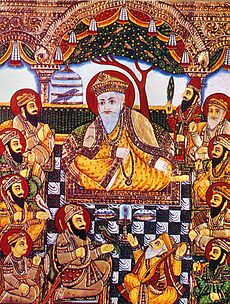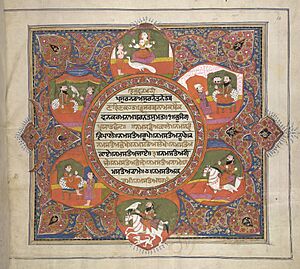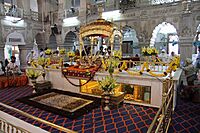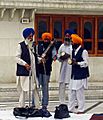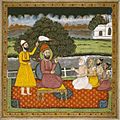Sikhism facts for kids
Quick facts for kids Sikhi |
|
|---|---|
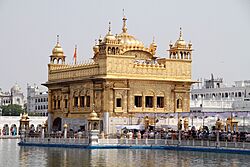
|
|
| Type | Ethnic religion |
| Classification | Indian |
| Scripture | Guru Granth Sahib |
| Theology | |
| Governance | Panj Takht |
| Region | Predominant religion in Punjab, India (58%), and widespread worldwide as minorities (Sikh diaspora) |
| Headquarters | Akal Takht, Amritsar, Punjab, India |
| Founder | Guru Nanak |
| Origin | 15th–16th century CE Punjab |
| Number of followers | c. 25–30 million (individually referred to as Sikhs, collectively referred to as Sikh Panth) |
Sikhism is an Indian religion that began in the Punjab region of the Indian subcontinent around the end of the 15th century. It is one of the world's major religions, with about 25 to 30 million followers. These followers are known as Sikhs.
Sikhism is based on the spiritual teachings of Guru Nanak (1469–1539), the first guru (or spiritual teacher). Nine other gurus followed him. The tenth guru, Guru Gobind Singh (1666–1708), named the holy book, the Guru Granth Sahib, as the final guru. This means the line of human gurus ended. Sikhs see the Guru Granth Sahib as a living teacher.
The main beliefs of Sikhism are written in the Guru Granth Sahib. Sikhs believe in one creator, called Ik Onkar. They believe all people are equal. They also believe in serving others selflessly (sevā), working for justice for all (sarbat da bhala), and living an honest life. Because of this, Sikhism teaches that no single religion has all the answers. Sikhs do not usually try to convert others to their faith, but people who choose to join are welcome.
Sikhs practice meditation to feel God's presence. This can be done through music called kirtan or by repeating God's name, known as naam japna. Sikhs who have been baptized, or initiated into the faith, must wear the Five Ks. These are five items that show they are Sikh. One of these is kesh, which means uncut hair. This is why many Sikh men wear a turban to cover their long hair.
The definition of a Sikh, according to the Rehat Maryada, the Sikh code of conduct, is any human being who faithfully believes in the following:
- One Immortal Being,
- Ten Gurus, from Guru Nanak Sahib to Guru Gobind Singh Sahib,
- The Guru Granth Sahib,
- The utterances and teachings of the ten Gurus and,
- The baptism bequeathed by the tenth Guru;

- Golden Temple, Akaal Takht
- Kesgarh Sahib
- Damdama Sahib
- Patna Sahib
- Hazur Sahib
- Panja Sahib
- Nankana Sahib
- Dera Sahib
- Ber Sahib
- Kartarpur Sahib, Dera Baba Nanak
- Hemkund Sahib
- Sis Ganj Sahib

The religion grew during times of religious persecution. People from both Hinduism and Islam became Sikhs. Two Sikh gurus, Guru Arjan and Guru Tegh Bahadur, were killed by Mughal emperors because they refused to convert to Islam. This led Guru Gobind Singh to create the Khalsa in 1699. The Khalsa is a community of Sikhs committed to protecting religious freedom. They are known as sant-sipāhī, which means "saint-soldiers."
Contents
Philosophy and Teachings
The foundation of Sikhism comes from the teachings of Guru Nanak and the gurus who followed him. Sikhs believe that spiritual life and daily moral actions go hand in hand. Guru Nanak said, "Truth is the highest virtue, but higher still is truthful living."
Belief in One God
Sikhism is a monotheistic religion, which means Sikhs believe in only one God. They call God Waheguru, which means "wondrous teacher." They also use the term Ik Onkar, meaning "One Creator."
Sikhs believe God is shapeless, timeless, and everywhere. God does not have a gender, but is sometimes described in masculine terms. For example, the Guru Granth Sahib describes all people as soul-brides who want to be with their husband, God.
The World as an Illusion
In Sikhism, Māyā is the idea that worldly attractions are a temporary illusion. Things like ego, anger, greed, and attachment are called the Five Thieves. They are believed to distract people from God. Sikhs believe that the world is in an "age of darkness" (Kali Yuga) because people are attached to māyā. The only way to fix this is through deep devotion to God.
Finding Liberation
Guru Nanak taught that the main goal of human life is to connect with God. To do this, a person must overcome their ego. Remembering God's name (nām) helps to end egotism.
Sikh teachings are not about reaching a heaven or hell. Instead, the goal is to achieve a spiritual union with God in this lifetime. This is called jivanmukti, or liberation. Sikhs believe in reincarnation and karma, but they also believe in God's grace. Guru Nanak said that a person is born because of karma, but they find salvation through grace.
Power and Devotion (Miri and Piri)
Miri Piri is a Sikh concept that combines worldly power (Miri) and spiritual authority (Piri). It was introduced by the sixth guru, Guru Hargobind. He wore two swords to show that a Sikh should be concerned with both society and their spiritual life. This idea developed into the "saint-soldier" concept, meaning a Sikh should have both spiritual qualities and the power to defend righteousness.
Music and Singing
Sikhs call the hymns of the gurus Gurbani (the Guru's word). Singing these hymns is called Shabad Kirtan. The entire Guru Granth Sahib is written as poetry and is meant to be sung. Guru Nanak taught that listening to kirtan is a powerful way to find peace and connect with God.
Service and Action
Sikh gurus taught that remembering God's name (naam simran) and doing selfless service (sēvā) helps a person overcome their ego. Service in Sikhism can be physical (Tan), mental (Man), or material (Dhan). Sikhs also believe in kirat karō (honest work) and vaṇḍ chakkō (sharing with others).
The Ten Gurus and Authority
The word "guru" comes from Sanskrit and means teacher or guide. Sikhism was established by ten gurus between 1469 and 1708. Each guru built upon the teachings of the one before.
- Guru Nanak was the first guru.
- Guru Angad standardized the Gurmukhī script for the holy writings.
- Guru Amar Das created ceremonies for birth, marriage, and death.
- Guru Ram Das founded the city of Amritsar.
- Guru Arjan built the Golden Temple and compiled the first version of the holy book, the Adi Granth.
- Guru Hargobind introduced the idea of Miri Piri and started a military tradition.
- Guru Har Rai continued the work of the previous gurus.
- Guru Har Krishan became guru at age five.
- Guru Tegh Bahadur stood up against forced conversions and was killed for his beliefs.
- Guru Gobind Singh was the final human guru. He created the Khalsa and declared the Guru Granth Sahib as the eternal guru.
The Akal Takht ("throne of the timeless one") in Amritsar is the highest center for making decisions in Sikhism. It sits opposite the Golden Temple.
Holy Scriptures
The main holy book for Sikhs is the Guru Granth Sahib. Another important text is the Dasam Granth, but it is considered a secondary scripture.
Guru Granth Sahib
The Guru Granth Sahib is considered the living guru of the Sikhs. It was first compiled by Guru Arjan in 1604 and was called the Ādi Granth. The final version was completed by Guru Gobind Singh.
The book contains the writings of six of the Sikh gurus. It also includes teachings from 13 Hindu saints and two Muslim saints. The text is written in the Gurmukhī script. It is made up of 6,000 hymns, or śabads, which are set to classical Indian music.
The Guru Granth Sahib is placed in every Sikh temple, or Gurdwara. Sikhs show great respect for the book, often bowing before it. It is treated like a living person and is seen as the ultimate spiritual guide.
Dasam Granth
The Dasam Granth is another holy book in Sikhism. Its writings are said to be from Guru Gobind Singh. It contains stories from Hindu mythology, as well as prayers that are part of daily Sikh worship, like the Jaap Sahib. Not all Sikhs agree on its authority, and it is a topic of debate within the religion.
Sikh Practices and Customs
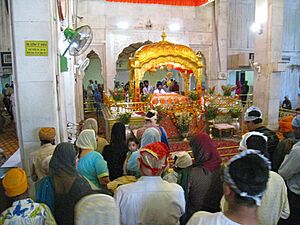
Observant Sikhs follow traditions to express their faith. They recite prayers from the Guru Granth Sahib every day. Families often read from the holy book and visit the gurdwara. Gurdwaras are open to everyone, no matter their religion or background.
Worship at a gurdwara mainly involves singing hymns from the scripture. A key practice is langar, a free community meal. The meal is always vegetarian, and everyone eats together. The kitchen is run by volunteers from the Sikh community.
Festivals
- Vaisakhi is one of the most important Sikh festivals. It celebrates the founding of the Khalsa.
- Bandi Chhor Divas is another major festival that celebrates freedom.
- Hola Mohalla is a festival started by Guru Gobind Singh. It includes displays of martial arts, horsemanship, and other military exercises.
Ceremonies
When a Sikh child is born, the Guru Granth Sahib is opened to a random page. The child is named with a name that starts with the first letter of the first word on that page. Boys are given the last name Singh (lion), and girls are given the last name Kaur (princess).
The Sikh marriage ceremony is called anand kāraj. It is performed in front of the Guru Granth Sahib. When a Sikh passes away, their body is usually cremated.
The Khalsa and the Five Ks
The Khalsa is the community of initiated Sikhs. The initiation ceremony is called ammrit sañcār. During the ceremony, Sikhs drink sweetened water that has been stirred with a double-edged sword.
Baptized Sikhs must wear five items at all times. These are called the Five Ks:
- Kēs: Uncut hair, which is kept clean and covered by a turban.
- Kaṅghā: A small wooden comb to keep the hair neat.
- Kaṛā: A steel bracelet worn on the wrist.
- Kirpan: A small sword or dagger, symbolizing the duty to defend the weak.
- Kaccherā: A special type of undergarment.
History of Sikhism
Sikhism was founded by Guru Nanak (1469–1539). He was born in a village now called Nankana Sahib in modern-day Pakistan. As a young man, he was very interested in spiritual matters. One day, he declared, "There is no Hindu, there is no Muslim," and began to teach his new ideas.
Growth and Persecution
Sikhism grew as it gained followers in the Punjab region. After Guru Nanak, a line of nine other gurus continued his work.
In the 17th century, the Sikh community faced persecution from the Mughal Empire. The fifth guru, Guru Arjan, was killed in 1606. This was a major turning point. His son, Guru Hargobind, became the sixth guru and started to build a military to protect the Sikhs.
The ninth guru, Guru Tegh Bahadur, was also killed in 1675 for defending religious freedom. His son, Guru Gobind Singh, then created the Khalsa in 1699 to form a community of "saint-soldiers."
-
Gurudwara Sis Ganj Sahib in Delhi. This is where Guru Tegh Bahadur was killed by the Mughals.
The Sikh Empire
-
A sculpture at Mehdiana Sahib showing the killing of Banda Singh Bahadur in 1716.
-
Bodyguards of Maharaja Ranjit Singh in Lahore.
After Guru Gobind Singh's death, the Sikhs formed a powerful confederacy. In the early 19th century, Ranjit Singh established the Sikh Empire. Its capital was in Lahore. The empire was known for its military strength. Ranjit Singh also restored and expanded the Harmandir Sahib, covering it with marble and gold. This is why it is now called the "Golden Temple."
After Ranjit Singh's death in 1839, the empire weakened. This led to wars with the British, which the Sikhs lost.
The Partition of India
In 1947, British India was divided into India and Pakistan. This event, known as the partition of India, was very difficult for the Sikhs. The new border, called the Radcliffe Line, ran through the middle of Punjab, the Sikh homeland.
This led to terrible violence. Millions of Sikhs and Hindus living in what became Pakistan had to move to India. Many lost their homes, property, and holy sites. It was a very traumatic time in Sikh history.
Sikhs Around the World
Today, there are about 25–30 million Sikhs worldwide. Most live in the Indian state of Punjab, where they make up about 58% of the population.
Large Sikh communities also exist in other countries. These include Canada, the United Kingdom, the United States, and Australia. These communities are often made up of Sikhs who moved from Punjab.
Images for kids
-
Mul Mantar written by Guru Har Rai, showing the Ik Onkar at top
-
A group of Sikh musicians called Dhadi at the Golden Temple complex
-
Sikh funeral procession, Mandi, Himachal Pradesh
-
Guru Nanak explaining Sikh teachings to Sadhus
-
Sikhs in London protesting against the Indian government
-
Nagar Kirtan in Bangalore
-
Sikhs celebrating Vaisakhi in Toronto, Canada
- Indian religions
- Bebe Nanaki
- Mai Bhago
- Five Virtues
- Hari Singh Nalwa
- Panjab Digital Library
- Turban training centre
- Women in the Guru Granth Sahib
- Idolatry in Sikhism
- Khalsa
- History of Sikhism
See also
 In Spanish: Sijismo para niños
In Spanish: Sijismo para niños




